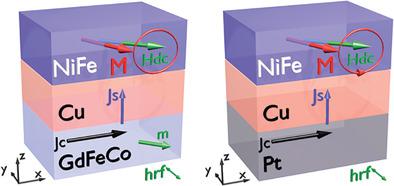当前位置:
X-MOL 学术
›
Adv. Mater.
›
论文详情
Our official English website, www.x-mol.net, welcomes your
feedback! (Note: you will need to create a separate account there.)
Current‐Induced Spin Torques on Single GdFeCo Magnetic Layers
Advanced Materials ( IF 27.4 ) Pub Date : 2021-02-19 , DOI: 10.1002/adma.202007047 David Céspedes‐Berrocal 1, 2 , Heloïse Damas 1 , Sébastien Petit‐Watelot 1 , Davide Maccariello 3 , Ping Tang 4 , Aldo Arriola‐Córdova 1, 2 , Pierre Vallobra 1 , Yong Xu 1 , Jean‐Loïs Bello 1 , Elodie Martin 1 , Sylvie Migot 1 , Jaafar Ghanbaja 1 , Shufeng Zhang 4 , Michel Hehn 1 , Stéphane Mangin 1 , Christos Panagopoulos 5 , Vincent Cros 3 , Albert Fert 3 , Juan‐Carlos Rojas‐Sánchez 1
Advanced Materials ( IF 27.4 ) Pub Date : 2021-02-19 , DOI: 10.1002/adma.202007047 David Céspedes‐Berrocal 1, 2 , Heloïse Damas 1 , Sébastien Petit‐Watelot 1 , Davide Maccariello 3 , Ping Tang 4 , Aldo Arriola‐Córdova 1, 2 , Pierre Vallobra 1 , Yong Xu 1 , Jean‐Loïs Bello 1 , Elodie Martin 1 , Sylvie Migot 1 , Jaafar Ghanbaja 1 , Shufeng Zhang 4 , Michel Hehn 1 , Stéphane Mangin 1 , Christos Panagopoulos 5 , Vincent Cros 3 , Albert Fert 3 , Juan‐Carlos Rojas‐Sánchez 1
Affiliation

|
Spintronics exploit spin‐orbit coupling (SOC) to generate spin currents, spin torques, and, in the absence of inversion symmetry, Rashba and Dzyaloshinskii–Moriya interactions. The widely used magnetic materials, based on 3d metals such as Fe and Co, possess a small SOC. To circumvent this shortcoming, the common practice has been to utilize the large SOC of nonmagnetic layers of 5d heavy metals (HMs), such as Pt, to generate spin currents and, in turn, exert spin torques on the magnetic layers. Here, a new class of material architectures is introduced, excluding nonmagnetic 5d HMs, for high‐performance spintronics operations. Very strong current‐induced torques exerted on single ferrimagnetic GdFeCo layers, due to the combination of large SOC of the Gd 5d states and inversion symmetry breaking mainly engineered by interfaces, are demonstrated. These “self‐torques” are enhanced around the magnetization compensation temperature and can be tuned by adjusting the spin absorption outside the GdFeCo layer. In other measurements, the very large emission of spin current from GdFeCo, 80% (20%) of spin anomalous Hall effect (spin Hall effect) symmetry is determined. This material platform opens new perspectives to exert “self‐torques” on single magnetic layers as well as to generate spin currents from a magnetic layer.
中文翻译:

单个GdFeCo磁性层上的电流感应自旋扭矩
自旋电子学利用自旋轨道耦合(SOC)产生自旋电流,自旋转矩,并且在没有反演对称性的情况下,产生Rashba和Dzyaloshinskii-Moriya相互作用。广泛使用的基于3d金属(例如Fe和Co)的磁性材料的SOC很小。为了避免此缺点,通常的做法是利用5d重金属(HMs)的非磁性层(例如Pt)的较大SOC产生自旋电流,然后在磁性层上施加自旋扭矩。在此,针对高性能自旋电子学的操作,引入了一类新的材料架构,除了非磁性5d HM之外。演示了由于Gd 5d态的大SOC和主要由界面引起的反对称性破坏的组合,施加在单个亚铁磁GdFeCo层上的非常大的电流感应扭矩。这些“自转矩”在磁化补偿温度附近得到增强,可以通过调节GdFeCo层外部的自旋吸收来调整。在其他测量中,确定了来自GdFeCo的非常大的自旋电流发射,80%(20%)的自旋异常霍尔效应(自旋霍尔效应)对称性。该材料平台开辟了新的视角,可以在单个磁性层上施加“自转矩”,并从磁性层产生自旋电流。
更新日期:2021-03-23
中文翻译:

单个GdFeCo磁性层上的电流感应自旋扭矩
自旋电子学利用自旋轨道耦合(SOC)产生自旋电流,自旋转矩,并且在没有反演对称性的情况下,产生Rashba和Dzyaloshinskii-Moriya相互作用。广泛使用的基于3d金属(例如Fe和Co)的磁性材料的SOC很小。为了避免此缺点,通常的做法是利用5d重金属(HMs)的非磁性层(例如Pt)的较大SOC产生自旋电流,然后在磁性层上施加自旋扭矩。在此,针对高性能自旋电子学的操作,引入了一类新的材料架构,除了非磁性5d HM之外。演示了由于Gd 5d态的大SOC和主要由界面引起的反对称性破坏的组合,施加在单个亚铁磁GdFeCo层上的非常大的电流感应扭矩。这些“自转矩”在磁化补偿温度附近得到增强,可以通过调节GdFeCo层外部的自旋吸收来调整。在其他测量中,确定了来自GdFeCo的非常大的自旋电流发射,80%(20%)的自旋异常霍尔效应(自旋霍尔效应)对称性。该材料平台开辟了新的视角,可以在单个磁性层上施加“自转矩”,并从磁性层产生自旋电流。











































 京公网安备 11010802027423号
京公网安备 11010802027423号